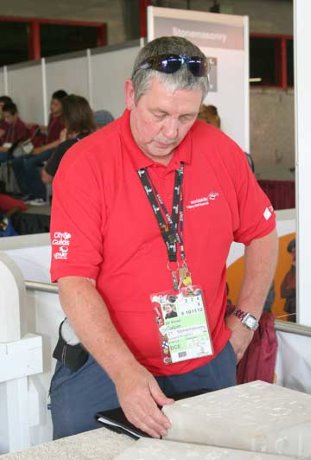Although most eyes were on the 845 competitors gathered at Stampede Park, they were far from the only experts taking part in WorldSkills Calgary 2009.
Training
Calgary
Although most eyes were on the 845 competitors gathered at Stampede Park, they were far from the only experts taking part in WorldSkills Calgary 2009.
Each competition also had a number of world experts on hand to act as a bridge between competitors and spectators, by explaining what the young craftspeople were doing.
They also performed the difficult task of judging the competitor’s work.
One such expert was deputy chief expert Kevin Calpin, a professional stonemason from the United Kingdom and one of a team of nine experts in the stonemasonry competition.
Like the competitors he oversaw, the expert’s involvement in the trade began when he was young.
Calpin said he began his career in stonemasonry at the age of 15, when he began an apprenticeship with the Ancient Monuments division of the Office of Works in the City of York.
“The division was responsible for all the ancient monuments in the York area, so all the work was done through the division I worked for,” he said, adding that the work allowed him to progress to the point where he was charged with overseeing other apprentices getting started in the trade.
“Then I moved around the departments to get more experience in things like management, techniques, estimation, looking at surveying, levelling, setting out,” he said.
With a full background in the trade, Calpin returned to the Ancient Monuments Division as superintendent and was responsible for buildings that spanned from Roman to contemporary times.
Calpin explained some of the differences between architecture at home and in North America.
“In Europe, the stonemasons have got to be aware of the architectural periods and they’ve got to have an awareness of the different types of materials that were used in those architectural periods,” Calpin said.
“Therefore, the grounding that the stonemason gets in Europe is slightly different from your counterparts in North America.”
Calpin began teaching the stonemason’s trade in 1982 on a part-time basis, training apprentices at the local college and eventually went on to establish a stonemasonry centre for northern England at York College.
Today, he works full time as a teacher and industry consultant.
His expertise in the trade led him to WorldSkills.
“In college when I was teaching, I used to put my students into regional competition,” he explained.
“If they won through to the regional, they would then go on to the finals, and if they were well placed in the finals, they might get trained to go off to WorldSkills.”
He went from training his own apprentices to be competition ready to being asked by the industry to organize the competitions regionally.
The construction industry then asked him to organize a national competition.
“It was just a progression from there,” he said.
“I was asked by UK Skills, which is my organizing body, if I wanted to become the WorldSkills training manager.”
The Calgary competition was Calpin’s third WorldSkills event, having previously volunteered his time in Helsinki, Finland in 2005 and Shizuoka, Japan in 2007.
Calpin explained that his main task as deputy chief expert was the co-ordination of the technical description – the blueprint of the competition skill – which established what the competitor should be able to do, what they should know as job knowledge and a break down of the individual modules of the competition.
In the case of Calpin’s skill category, competitors were given the task of creating an architectural feature out of three different pieces of stone, using a variety of stonemasonry skills. This included carving letters and a maple leaf design.
Long before the finishing touches were done, careful planning was needed.
“They’ve got to understand complex geometry to be able to set the whole of the work out,” he said.
Calpin explained that marking is broken down into modules: one for templates and patterns, one for letter cutting and carving and one module for the actual stonemasonry.
Each module is further broken down into sub-criteria, which is judged either objectively or subjectively.
“For instance, the templates are marked very rigidly up against a full-size AutoCAD drawing, so we can actually see whether or not the templates fit the work,” he said. “Alternatively… the letter cutting and carving is totally subjective.”
A team of five experts examine, discuss and make notes on the work before giving it marks.
When the chief expert asks for the mark, all five judges simultaneously display their flash cards, offering a score between 1 and 10.
But, not all marks are used in the final score as the top and bottom mark are discarded.
RELATED STORIES











Recent Comments
comments for this post are closed